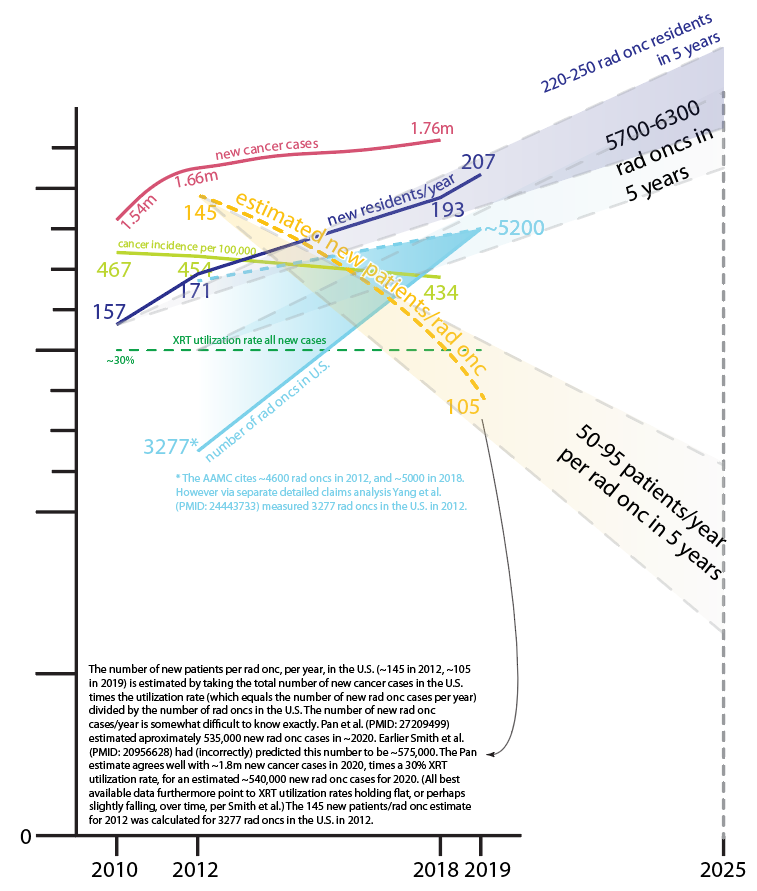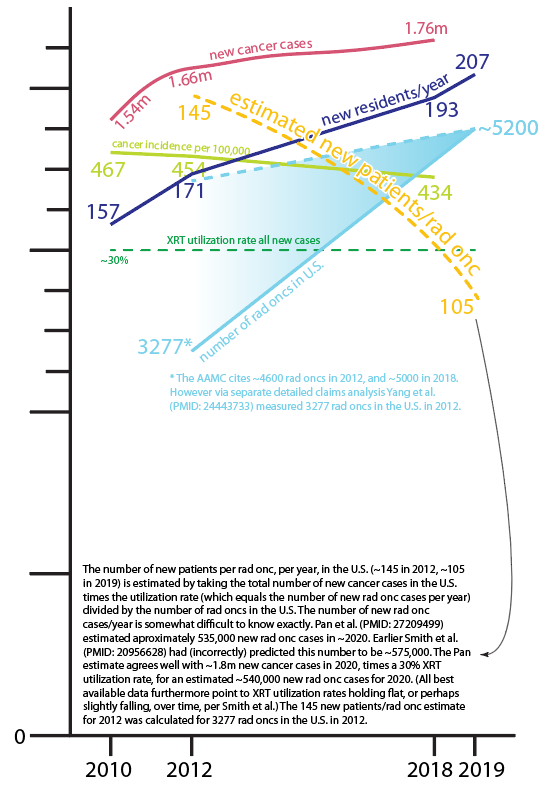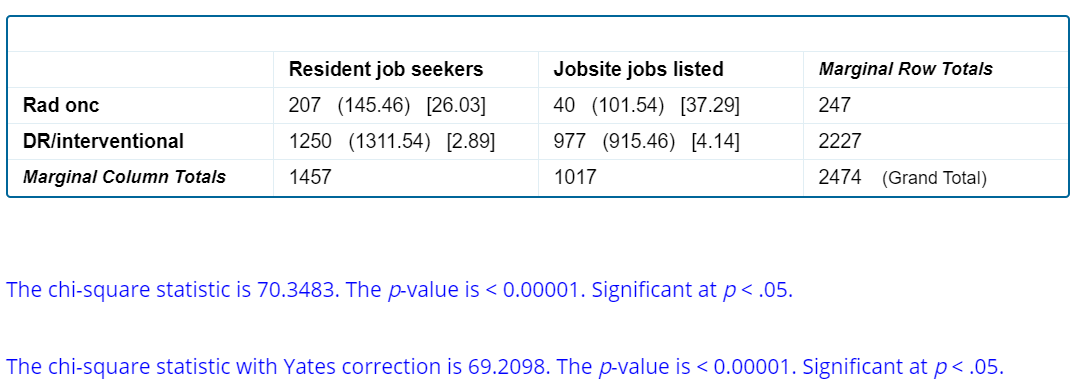- Joined
- Dec 18, 2015
- Messages
- 3,216
- Reaction score
- 4,930
(updated the figure)

Sources
1. Supply and Demand for Radiation Oncology in the United States: Updated Projections for 2015 to 2025. "In comparison with prior projections, the new projected demand for radiation therapy in 2020 dropped by 24,000 cases (a 4% relative decline). This decrease is attributable to an overall reduction in the use of radiation to treat cancer, from 28% of all newly diagnosed cancers in the prior projections down to 26% for the new projections."
2. AAMC Physician Specialty Data Report.
3. Projected Supply of and Demand for Oncologists and Radiation Oncologists Through 2025: An Aging, Better-Insured Population Will Result in Shortage. "We found that approximately 16,347 oncologists and radiation oncologists were clinically active and filing medical claims for patients with cancer diagnoses in 2012. Among these, there were 13,070 oncologists and 3,277 radiation oncologists. We found that 16% of oncologists and 5% of radiation oncologists provided clinical care on a part-time basis. These oncologists and radiation oncologists engaged in part-time clinical care delivered 48% of the patient care visits that their peers in full-time patient care provided. This finding is consistent with those of prior surveys showing academic oncologists, on average, spent 48.3% of their time on clinical activities.18 As a result of lower clinical productivity, we estimated by experience and sex the number of oncologists and radiation oncologists providing FTE patient care in the beginning of 2012 to be 15,190, including 12,000 oncologists and 3,190 radiation oncologists."
4. Decreasing radiation therapy utilization in adult patients with glioblastoma multiforme: a population-based analysis.
5. Trends in Radiation Therapy among Cancer Survivors in the United States, 2000–2030. "In 2016, there were an estimated 10.5 million 5-year cancer survivors, of whom 3.05 million received radiation therapy... The fraction of all cancer survivors who received radiation increased from 24% in 2000 to a projected maximum of 29% in 2020. After 2020, the fraction of radiation-treated survivors is projected to slightly decline to 28% by 2030."
6. Declining Use of Radiotherapy for Adverse Features After Radical Prostatectomy: Results From the National Cancer Data Base.
7. The Future of Radiation Oncology in the United States From 2010 to 2020: Will Supply Keep Pace With Demand?
* "Between 2010 and 2020, the total number of patients receiving radiation therapy during their initial treatment course is expected to increase by 22%, from 470,000 per year to 575,000 per year. In contrast, assuming that the current graduation rate of 140 residents per year remains constant, the number of full-time equivalent radiation oncologists is expected to increase by only 2%, from 3,943 to 4,022. The size of residency training classes for the years 2014 to 2019 would have to double to 280 residents per year in order for growth in supply of radiation oncologists to equal expected growth in demand."
* "We conducted a sensitivity analysis to determine how changes in the utilization of radiation therapy and in the incidence of cancer would impact the relative increase in demand for radiation therapy between 2010 and 2020. To estimate appropriate parameters for the sensitivity analysis of radiation therapy utilization, we conducted a historical analysis using SEER data spanning 1990 to 2006 and found that, compared with the years 2003 to 2005, radiotherapy utilization rates generally varied no more than approximately ± 10% during this time period (Fig 1).4 With regard to the cancer incidence sensitivity analysis, previously published historical data indicated that cancer incidence has both increased and decreased in a statistically significant manner between 1975 and 2006; recently however, cancer incidence has been slowly decreasing at a rate of 0.4% per year from 1997 to 2006, and this rate increases to 0.7% per year if only the years 2002 to 2006 are considered.
8. NRMP Report Archives.
9. United States Cancer Statistics: Data Visualizations.
10. American Cancer Society Facts & Figures.
11. Radiotherapy Utilization and Fractionation Patterns During the First Course of Cancer Treatment in the United States From 2004 to 2014. "We found a steady decrease in the percent of patients receiving radiotherapy in their first course of treatment, and a global decline in the mean number of fractions delivered per patient receiving EBRT, compared with an increase in systemic therapy and stable surgery utilization. "

Sources
1. Supply and Demand for Radiation Oncology in the United States: Updated Projections for 2015 to 2025. "In comparison with prior projections, the new projected demand for radiation therapy in 2020 dropped by 24,000 cases (a 4% relative decline). This decrease is attributable to an overall reduction in the use of radiation to treat cancer, from 28% of all newly diagnosed cancers in the prior projections down to 26% for the new projections."
2. AAMC Physician Specialty Data Report.
3. Projected Supply of and Demand for Oncologists and Radiation Oncologists Through 2025: An Aging, Better-Insured Population Will Result in Shortage. "We found that approximately 16,347 oncologists and radiation oncologists were clinically active and filing medical claims for patients with cancer diagnoses in 2012. Among these, there were 13,070 oncologists and 3,277 radiation oncologists. We found that 16% of oncologists and 5% of radiation oncologists provided clinical care on a part-time basis. These oncologists and radiation oncologists engaged in part-time clinical care delivered 48% of the patient care visits that their peers in full-time patient care provided. This finding is consistent with those of prior surveys showing academic oncologists, on average, spent 48.3% of their time on clinical activities.18 As a result of lower clinical productivity, we estimated by experience and sex the number of oncologists and radiation oncologists providing FTE patient care in the beginning of 2012 to be 15,190, including 12,000 oncologists and 3,190 radiation oncologists."
4. Decreasing radiation therapy utilization in adult patients with glioblastoma multiforme: a population-based analysis.
5. Trends in Radiation Therapy among Cancer Survivors in the United States, 2000–2030. "In 2016, there were an estimated 10.5 million 5-year cancer survivors, of whom 3.05 million received radiation therapy... The fraction of all cancer survivors who received radiation increased from 24% in 2000 to a projected maximum of 29% in 2020. After 2020, the fraction of radiation-treated survivors is projected to slightly decline to 28% by 2030."
6. Declining Use of Radiotherapy for Adverse Features After Radical Prostatectomy: Results From the National Cancer Data Base.
7. The Future of Radiation Oncology in the United States From 2010 to 2020: Will Supply Keep Pace With Demand?
* "Between 2010 and 2020, the total number of patients receiving radiation therapy during their initial treatment course is expected to increase by 22%, from 470,000 per year to 575,000 per year. In contrast, assuming that the current graduation rate of 140 residents per year remains constant, the number of full-time equivalent radiation oncologists is expected to increase by only 2%, from 3,943 to 4,022. The size of residency training classes for the years 2014 to 2019 would have to double to 280 residents per year in order for growth in supply of radiation oncologists to equal expected growth in demand."
* "We conducted a sensitivity analysis to determine how changes in the utilization of radiation therapy and in the incidence of cancer would impact the relative increase in demand for radiation therapy between 2010 and 2020. To estimate appropriate parameters for the sensitivity analysis of radiation therapy utilization, we conducted a historical analysis using SEER data spanning 1990 to 2006 and found that, compared with the years 2003 to 2005, radiotherapy utilization rates generally varied no more than approximately ± 10% during this time period (Fig 1).4 With regard to the cancer incidence sensitivity analysis, previously published historical data indicated that cancer incidence has both increased and decreased in a statistically significant manner between 1975 and 2006; recently however, cancer incidence has been slowly decreasing at a rate of 0.4% per year from 1997 to 2006, and this rate increases to 0.7% per year if only the years 2002 to 2006 are considered.
8. NRMP Report Archives.
9. United States Cancer Statistics: Data Visualizations.
10. American Cancer Society Facts & Figures.
11. Radiotherapy Utilization and Fractionation Patterns During the First Course of Cancer Treatment in the United States From 2004 to 2014. "We found a steady decrease in the percent of patients receiving radiotherapy in their first course of treatment, and a global decline in the mean number of fractions delivered per patient receiving EBRT, compared with an increase in systemic therapy and stable surgery utilization. "
Last edited:



